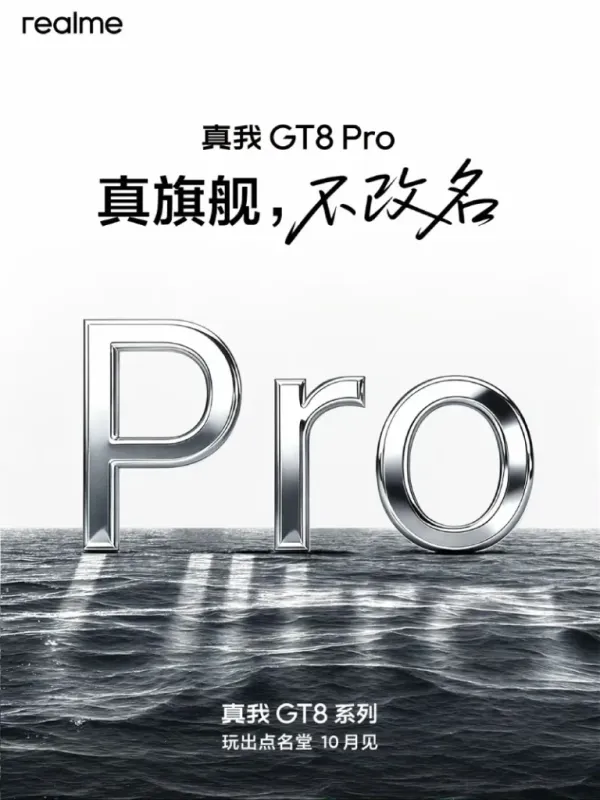
Realme has officially confirmed the launch of its upcoming GT 8 and GT 8 Pro flagship smartphones in October 2025. Pre-orders have already opened up in China, with early-bird customers willing to pay a small fee getting additional benefits. For Realme, the GT line has long served as the company’s testing ground for audacious concepts, combining high-end processors with ambitious designs. With the GT 8 series, the company seems committed to doubling down on battery life, camera technology, and uncompromising performance, while refining the design vocabulary of its premium phones.

With Realme already setting up its home market for the release, it seems that the October timeline is all but confirmed. It is available for pre-orders in China, the first region to get the devices, with wider availability to come in India and Europe shortly after. This is Realme’s typical pattern of releasing its flagship at home before expanding to international markets. Pricing is under wraps for the moment, but the pre-ordering suggests that the business feels sure of stoking enthusiasm way ahead of the special day.
Realme GT 8 Pro: 6.78-inch 2K OLED display, thin bezels, LTPO adaptive refresh rate (up to 120 Hz+).
Realme GT 8: 6.6-inch flat OLED panel, featuring a high refresh rate but lower resolution for enhanced affordability.
A previously surfaced shot of the GT 8 inside a heavy-duty case revealed a square-shaped camera island, rumored to be positioned in the top left corner of the handheld. Reports also suggest a co-branding with Ricoh, bringing its “Negative Film” style to the smartphone market for the very first time.
One of the most daring rumors around the GT 8 Pro is its camera system.
GT 8 Pro: Rumored 200MP periscope telephoto lens, backed by a high-resolution primary sensor and ultrawide lens. If confirmed, this would make it one of the most ambitious mobile cameras to date.
GT 8: More conservative setup with a solid primary and supporting lenses, focusing on balanced photography performance.
The test for Realme will not just be about higher megapixel counts but also image processing, stabilization, and low-light optimization.
The GT 8 standard will likely remain more conservative, featuring a decent primary lens and supporting lenses. For Realme, the test will not only provide higher megapixel numbers but also verify whether image processing, stabilization, and low-light performance match the hardware’s promise.
On the front, the Pro is likely to feature a 6.78-inch OLED screen with a 2K-class resolution, thin bezels, and possibly an adaptive refresh rate of more than 120 Hz, thanks to LTPO technology. The default GT 8, on the other hand, is said to have a slightly smaller flat screen, measuring around 6.6 inches, with the same high refresh rate but a lower resolution to keep costs in check. To know for sure, audiences will have to wait till October for its launch.
As with each GT series, performance will probably reign supreme in the Realme GT 8 and GT 8 Pro. Both phones are said to be powered by Qualcomm’s new high-end chipset, widely speculated to be the Snapdragon 8 Elite Gen 5.
This promises:
Gaming is expected to be a major highlight, with Realme rumored to include advanced thermal management to ensure sustained performance.
Although the eventual naming of the processor has yet to be confirmed, leaks suggest an emphasis on improving CPU and GPU performance without compromising efficiency.
This hardware can be further enhanced with the latest UFS 4.x storage for lightning-fast data access and LPDDR5X memory to ensure smooth multitasking. Gaming will also probably be a major focus point if Realme highlights thermal management and persistent performance, two aspects that can make or break a flagship experience.
One of the highlights of the Realme GT 8 is its battery capacity.
Realme GT 8: Massive 7,000 mAh battery (one of the largest ever in a flagship).
Realme GT 8 Pro: Even bigger capacity expected.
Leaks reveal unusually large batteries for both phones, with capacities ranging from 7,000 mAh for the GT 8 to even higher figures reported for the Pro.
This approach directly appeals to the consumer’s need for devices that can withstand more than a day of heavy use. Ultra-fast wired charging technology will likely remain one of Realme’s strong suits, with incredibly rapid wired charging supported, although specific wattage ratings remain uncertain. Combined, the charging and battery package may make the GT 8 series one of the most endurance-friendly smartphones of 2025.
In terms of software, the Realme GT 8 and GT 8 Pro will have the newest versions of Realme’s UI, based on Android 15. Key expected features:
Software support has also become a primary battlefield between smartphone manufacturers, and Realme will likely emphasize long-term update promises to calm customers. Realme may also introduce exclusive color options or special edition models at launch. So it would not be out of character to hear special editions announced at the October event.
While Realme hasn’t revealed pricing yet:
Historically, Realme GT phones have delivered more hardware for less money than competitors, and this strategy is unlikely to change.
Price is always one of Realme’s most powerful levers. The GT 8 Pro, with its reportedly 200MP periscope and high-end display, will likely be positioned closer to the conventional flagship price, while the regular GT 8 will likely undercut most competitors yet maintain flagship performance. Historically, the GT series has established its brand by delivering more hardware for the money spent than its rivals, and that positioning is unlikely to change.
If you’re looking for:
Then the Realme GT 8 series could be one of the best smartphone options in late 2025.
If Realme can follow through on both the hardware promises and the software polish, the GT 8 series might be one of the most thrilling and competitive flagship options in late 2025. For consumers who require large batteries, aggressive designs, and high-end performance without ultra-premium price tags, the GT 8 series may be the ideal choice.